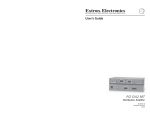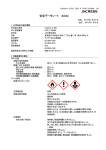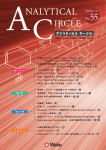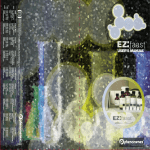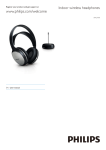Download Operating Instructions
Transcript
Operating Instructions Affinity Chromatography Media (for ligand coupling) Cellufine Formyl Description Cellufine Formyl is an aldehyde activated support for the covalent immobilization of amine containing proteins and ligands. As with all Cellufine products, the base support consists of spherical cellulose beads which exhibit superior rigidity and chemical stability relative to classical agarose gels. Such mechanical strength allows for improved throughput at both the bench scale and on the production floor. The exclusion properties of Cellufine Formyl are similar to those of 4 % agarose gels. Furthermore, due to the robust internal structure and chemical linkage, immobilized ligands show no appreciable leakage. With the use of a condensation agent, ligands (proteins, etc.) can be easily coupled via the reactive aldehyde moiety. Physical-Chemical Characteristics Base media porous cellulose spherical beads Particle Size ca. 125-210 µm Activated group Formyl ( aldehyde ) Formyl group conc. 10µmol/ml-gel Delivery condition 0.2M Acetate buffer,pH3.0 containing 0.01% 2,2-dithio-bis(pyridine-1-oxide) Coupling (reductive amination) The coupling of protein ligands having primary amino groups to Cellufine Formyl proceeds via a Schiff’s-base intermediate followed by reduction with reducing agent NaCNBH3 (SCBH), (CH3)3NBH3(TMAB) and NaBH4 (SBH) as illustrated below: Preincubation R O C + H2N R H Cellufine-Formyl Ligand OH C R R N H H reductive amination H2O H2O Reducing agent R C R N H Schiff base H R C R N H H Ligand-immobilized Cellufine Materials ■ Coupling buffer: The buffer solution which does not contain a primary amine, the range of pH 4 to 11, and concentration are about 0.2M, a phosphate buffere, an acetate buffere, HEPES buffer solution, etc. can use. ■ Blocking buffer: 0.2M to 1M of Primary-amine compounds in coupling buffer, such as ethanol-amine, glycine and glycine ethyl ester, etc or 0.2M to 1M of Tirs-HCl buffer pH 7 to 8 is used. ■ Reducing agent: the most common reducing agents are sodium cyanoborohydride (SCBH), Trimethylamjneborane(TMAB) and sodium Borohydride (SBH). SCBH (CAS 25895-60-7) (Sodjumcyanoborohydride) NaCNBH3 TMAB (CAS 75-22-9 ) (Trimethylamjneborane) (CH3)3NBH3 SBH (CAS 16940-66-2) (Sodiumborohydride) NaBH4 Caution: Advantage Protein and aldehyde compound is not reduced, but a Schiff’s-base is reduced selectively. Reduction force is weak and there is almost no damage given to protein. Blocking operation is unnecessary. Toxicity is low. Demerit Toxic substance Note used at a draft chamber Waste processing necessity pH ≥ pH4 Solubility is low. (1.3% of solubility to water) The pre incubation of 1 to 2 hour is required. ≥ pH5 Since reduction force is strong, a formyl group is reduced. In special protein, use is impossible. (A S-S binding is reduced) The pre incubation of 1 to 2 hour is required. ≥ pH7 Solution of SCBH should be made in a well ventilated area, since a small amount of toxic gas will be generated upon solubilization. ■ Ligand solution: typically, 1 – 20 mg/ml in coupling buffer. Coupling efficiency decreases in 20mg/ml or more. Note: total mass coupled will be directly related to concentration (see Fig. 1). 60 100 80 40 60 30 40 20 20 10 0 0 20 40 60 80 ligand coupling efficiency (%)■,□ coupling [ mg/g ] ●,○ 50 0 100 ligand [ mg/ml ] Fig.1 The effect of the concentration of ligand in the coupling reaction. hγGlo. Coupling hγGlo. Coupling ratio www.amsbio.com HAS Coupling HAS Coupling ratio [email protected] General Coupling Procedure Table.1 The summary of operation ( Required quantity per 1mL gel) 1 Cellufine Formyl preservation solution is washing-removed. 1ml (0.7g to 0.8g- wet-g) 2 Coupling buffer Coupling buffer solution containing ligand (1 to 2 ml) Refer to the “Coupling Considerations” for ligand concentration 3 Preincubation agitates gently for 1 to 2 hours (preincubation is unnecessary when SCBH is used.) 4 Reducing agent reducing agent adds 5-10mg. (Instead of powder, it’s may add 50 to 100mg/ml of 1ml reducing agents.) 5 Coupling reaction agitates gently for 2 - 8 hours It depends for the temperature suitable for a reaction on the stability of a ligand. 6 Washing A reaction solution is removed by filtration or decantation. washes in several times by coupling buffer 20ml. The amount of coupling can be calculated by measuring the ligand concentration contained in reaction solution and washing solution. 7 Blocking reaction 1-2ml blocking solution is added to the washed gel, and the same quantity as a reducing agent (4) is applied. agitates gently for about 2 hours 8 Washing A reaction solution is removed by filtration or decantation. Washes in several times by 20ml of coupling buffer 2 or water. Perform the following in a suitable mixing vessel. 1. Estimate the required volume of medium. As for the bottle of a product, about 50% of Cellfuine slurry is contained. 2. Preservation solution is removed by filtration or decantation. Washes in several times by coupling buffer 10 to 20ml. (until an acetic acid smell is lost.) 3. Add the ligand solution at a 1 to 2 times of gel volume. This will form a total slurry volume approximately 2 to 3 times the original volume of medium. 4. If using SCBH, preincubation is not necessarily required. 5. If using SBH, blocking reaction is unnecessary. Because, SBH is for reducing aldehyde (Formyl) and turning it a hydroxyl group. Note SCBH waste solution dispose of in a manner consistent with federal, state, and local regulations. And please refer to MSDS of a SCBH manufacture company. Coupling Considerations Ligand loading and biochemical activity are influenced by solute concentration, pH, reaction time and temperature. The coupling conditions above will be appropriate for most applications. Ligand Concentration Ligand loading is directly related to the ligand concentration. (See Fig.1.) Using a 50 % slurry (1 ml gel per 1 ml ligand solution) and about 10 mg/ml ligand concentration, 60 % coupling can www.amsbio.com [email protected] be achieved in approximately 4 hours, at room temperature. Higher efficiency can be obtained with longer reaction times.(See Fig.3) 35 30 coupling [ mg/ml ] ligand coupling efficiency (%) 100 80 60 40 25 20 15 10 5 hγGlobulin HAS 0 20 0 5 10 15 reaction time [ H ] 20 0 2 3 4 5 6 7 pH 8 9 10 11 12 Fig.2 The effect of pH of coupling buffer on the amount of ligand coupled to the gel Fig3 The relation between the time for coupling reaction and the quantity of coupled protein. hγGlobulin(30ºC) hγGlobulin(4ºC) HAS(30ºC) HAS(4ºC) pH of a coupling buffer Optimal pH changes with protein types. pH stability and reaction efficiency of a ligand are taken into consideration. Generally pH higher than pI goes up reaction efficiency .(See Fig.2.) Schiff’s base Formation and Reduction A Schiff’s base is readily formed between the amine ligand and aldehyde-gel. Sodium cyanoborohydride specifically reduces this linkage to a C - N bond, minimally affecting the ligand. Given such specificity, sodium cyanoborohydride can be added at time zero. In contrast, if BaBH4 is used there should be a pre-incubation period in order to allow Schiff’s base formation. Otherwise, the aldehyde moiety will be prematurely reduced. Reaction Temperature Lower temperature result in lower reaction rate and in some cases, less efficient coupling. As such, recommended reaction time should be increase to 16 hours, if refrigeration at 4 °C is required. Column Packing 1. Calculate volume required for the desired bed dimension, keeping in mind that bed compression will occur during column packing. 2. Prepare a 40 – 60 % (v/v) slurry with the appropriate adsorption buffer. 3. With outlet closed, pour the slurry into column. Depending on the volume, a filler tube may www.amsbio.com [email protected] be necessary. 4. With the inlet open to release air, insert and affix the top adjuster assembly at slurry interface. 5. Open the column outlet and begin pumping adsorption buffer at rate at least 20 % higher than the operational flow rate. 6. After the bed stabilizes, close the column outlet. Then, with the inlet open, reposition the end cell on top of the bed. Operating Guidelines General Operation 1. Wash column with 5 bed volumes of elution buffer. 2. Equilibrate with 5 bed volumes of adsorption buffer. 3. Load sample. 4. Wash with 5 bed volumes of adsorption buffer. 5. Elute sample with 5 bed volumes of elution buffer Recommended Buffers These conditions will depend on the ligand used. However, the following are generally useful for immuno-affinity chromatography. Adsorption buffer: 20 mM phosphate, 0.1 M NaCl (pH 7.2). Depending on application, other buffer ions may be used. Elution buffer: 0.1 M glycine, pH 3.5 Sample Preparation and Load Prepare a 1 – 10 mg/ml solution of sample in adsorption buffer. Remove insoluble material by centrifugation or microfiltration. Flow Rate The recommended linear velocity range for Cellufine Formyl is 20 – 150 cm/h. Chemical and Physical Stability The stability of the coupled gel will be limited by the ligand. However, the base gel is stable to most salts, detergents, chaotropic agents, 0.1 N NaOH, 0.1 N HCl and can be autoclaved at 121°C for 30 minutes at pH 7.0. www.amsbio.com [email protected] Regeneration The regeneration protocol will depend on ligand stability. In some cases, a few bed volume washes with elution buffer containing 0.1 % Tween®20 or Triton® X-100 will be sufficient. A similar wash with 6 M urea can also be effective. Storage For storage of opened containers, it is recommended that they be kept in a cold room (2 - 8 °C). Do not freeze. Shelf Life 5 years from date of manufacture Product Ordering Information (Catalogue No.) Pack Size Media type 10 ml Cellufine Formyl 676 944 324 50 ml 19853 500 ml 5 lt 19854 19855 10 lt 676 944 335







